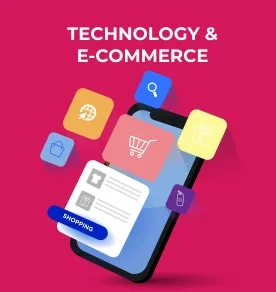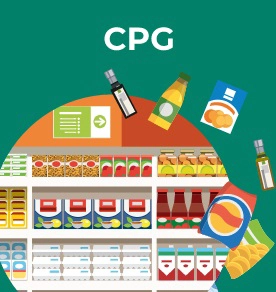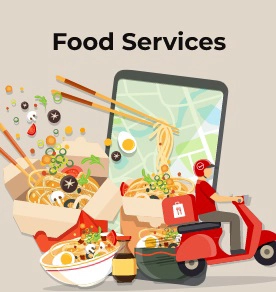Transforming the Food & Grocery Sector

These trends are driving innovation and redefining how consumers shop for and engage with food products.
By Vaishnavi Gupta, Assistant Editor
Jan 22, 2025 / 10 MIN READ
The food and grocery (F&G) sector is undergoing a remarkable transformation as evolving consumer preferences, technological advancements, and sustainability concerns reshape the landscape. These trends are driving innovation and redefining how consumers shop for and engage with food products. Here, we explore the prominent trends steering the future of this dynamic industry.
1. Health-Conscious Consumption
Consumers today are increasingly health-conscious, prioritizing well-being and nutrition in their purchasing decisions. There is a growing demand for organic, gluten-free, non-GMO, and plant-based products, driven by a desire for cleaner and more sustainable eating. Brands and retailers are responding with healthier product lines, catering to dietary needs such as keto, vegan, and low-sugar options. This shift signifies a move toward mindful consumption, with customers actively seeking products that align with their personal health goals.
2. Convenience and Meal Kits
Modern lifestyles have fueled the demand for convenient food solutions, particularly ready-to-cook meal kits and pre-packaged ingredients. These options cater to busy consumers who seek quick yet nutritious meals, reducing meal prep time and food waste. The meal kit segment has surged in popularity, with brands offering diverse cuisines and customized options to suit individual tastes. This trend underscores a broader preference for simplicity and time efficiency in meal planning.
3. Technology Integration and Automation
The infusion of technology in the F&G sector has revolutionized the shopping experience. Grocery retailers are adopting cutting-edge solutions to streamline operations and enhance convenience. Mobile apps, self-checkout kiosks, and cashier-less stores are becoming commonplace, allowing shoppers to purchase items seamlessly. Innovations such as augmented reality (AR) for virtual product trials and AI-powered inventory management systems are further optimizing the retail experience. These advancements cater to tech-savvy customers and improve operational efficiency.
4. E-Commerce Growth and Digital Adoption
The COVID-19 pandemic accelerated the adoption of online grocery shopping, establishing it as a mainstay for many consumers. Digital platforms offer the convenience of home delivery, contactless transactions, and time-saving benefits, making them an essential part of the shopping ecosystem. As competition in e-commerce intensifies, retailers are differentiating themselves through personalized recommendations, subscription models, and value-added services like same-day delivery.
5. Sustainability in Focus
Environmental concerns are shaping consumer choices, with sustainability becoming a key purchasing driver. Shoppers are gravitating toward products with eco-friendly packaging, locally sourced ingredients, and brands that demonstrate a commitment to reducing their carbon footprint. Retailers, in turn, are emphasizing transparency in their supply chains and adopting sustainable practices to align with customer values. This eco-conscious shift underscores a collective effort to create a greener future.
6. Personalization Through Data and AI
Retailers are leveraging data analytics and artificial intelligence (AI) to personalize the customer experience. By analyzing consumer behavior, preferences, and purchase history, retailers can tailor product recommendations and marketing campaigns to individual needs. Personalization enhances customer engagement, boosts satisfaction, and fosters loyalty, ultimately driving sales and long-term growth.
7. Global and Ethnic Food Exploration
An increasing appetite for global flavors is diversifying product offerings in grocery stores. Consumers are exploring international cuisines and ethnic foods, reflecting a desire for culinary adventures. Retailers are expanding their selections of imported goods, spices, and specialty items to cater to this demand. This trend highlights the growing role of food as an experiential journey, connecting consumers with cultures worldwide.
8. Robotic Assistance in Kitchens
In the realm of kitchen innovation, robotic assistants are emerging as tools to simplify meal preparation. These robots handle tasks such as chopping, assembling, and cooking, enhancing convenience and efficiency. By integrating AI and robotics, these devices cater to tech-forward consumers, making cooking accessible and enjoyable.
Source: 1Lattice
The food and grocery (F&G) sector is undergoing a remarkable transformation as evolving consumer preferences, technological advancements, and sustainability concerns reshape the landscape. These trends are driving innovation and redefining how consumers shop for and engage with food products. Here, we explore the prominent trends steering the future of this dynamic industry.
1. Health-Conscious ConsumptionConsumers today are increasingly health-conscious, prioritizing well-being and nutrition in their purchasing decisions. There is a growing demand for organic, gluten-free, non-GMO, and plant-based products, driven by a desire for cleaner and more sustainable eating. Brands and retailers are responding with healthier product lines, catering to dietary needs such as keto, vegan, and low-sugar options. This shift signifies a move toward mindful consumption, with customers actively seeking products that align with their personal health goals.
Related Stories
There’s a quiet revolution simmering in your kitchen pantry — and it smells like aged, aromatic basmati rice. Once confined to Indian households and diaspora kitchens, this fragrant, long-grain rice…
- By Nandini Banerjee
- |
- 11 Min Read
The food and grocery (F&G) sector is undergoing a remarkable transformation as evolving consumer preferences, technological advancements, and sustainability concerns reshape the landscape. These…
- By Vaishnavi Gupta
- |
- 6 Min Read
In the crowded landscape of Indian FMCG, where traditional snacks like bhujiya and imported chips dominate, 4700BC carved out an unexpected niche. Founded by Chirag Gupta, this gourmet popcorn brand…
- By Aritra Ghosh
- |
- 9 Min Read




